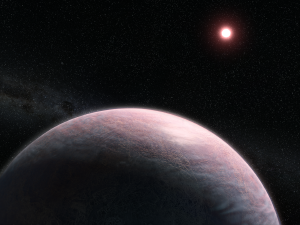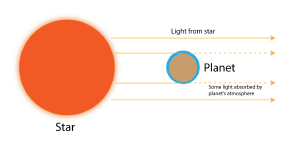Blog
See the Sky
3 December 2019
 L. Hustak and J. Olmsted (STScI)
L. Hustak and J. Olmsted (STScI)There are thousands of known exoplanets in the galaxy. They are so common that there are likely billions of them in the Milky Way. Many of them are “potentially habitable,” meaning that they have just the right distance from their star to be not-too-hot and not-too-cold. But potentially habitable is a long way from actually habitable. To meet that criteria (at least for Earth-like life) they would also need to have liquid water and a rich atmosphere.
Most of the exoplanets we have found orbit small red dwarf stars. That’s partly because its easier to find planets around small stars, but it’s also because most stars in the galaxy are small. It’s estimated that about 70% of all the stars in the universe are red dwarfs.
Since red dwarfs are smaller and cooler than our Sun, their habitable zone is much smaller. Potentially habitable planets around a red dwarf orbit at distances much closer to the star than Mercury does in our solar system. This could be a problem, because red dwarfs are known to go through periods of strong stellar activity. Planets close to a red dwarf might be stripped of any atmosphere before life ever has a chance to form.
 Brian Koberlein
Brian KoberleinOne way to detect the atmosphere of an exoplanet is to measure its effect on starlight. When an exoplanet passes in front of its star, it blocks some of the starlight, making it appear dimmer. This “transit method” is how most exoplanets have been discovered. If the exoplanet has an atmosphere, then the starlight will be distorted slightly. By observing the first and last moments of a transit, astronomers can see the effects of the atmosphere, and can even study its composition. But this is difficult to do, and works best with large exoplanets with thick atmospheres. It is not effective for Earth-sized planets with thin atmospheres.
But recently a team of astronomers have proposed an alternative method.1 One that could be done easily and quickly. Rather than observing the atmosphere directly, the team suggests looking at how the atmosphere affects the temperature of the planet.
Because the potentially habitable planets of red dwarfs orbit so closely, they are likely to be tidally locked the way the Moon is with Earth), or have a strong tidal resonance as is the case for Mercury orbiting the Sun. This means one side of the planet will tend to be “locked” facing the star. Without an atmosphere, the temperature difference between the starlit and shadowed sides of the planet would be extreme. With an atmosphere the temperature difference would be moderated.
So the team proposes looking at the temperature of the planet as it transits the star. If the planet has temperature swings seen in bare rock, then it would prove the planet has no atmosphere. Currently, we can’t make such observations, but it could be done by the James Webb Space Telescope when it is launched in 2021.
The method would work best for planets too hot to be habitable, but if the hot rocky planets of red dwarfs have atmospheres, cooler planets are also likely to have them. If that’s the case, then the most common stars in the universe could also be the ones most likely to be home to alien life.
Koll, Daniel DB, et al. “Identifying Candidate Atmospheres on Rocky M dwarf Planets via Eclipse Photometry.” arXiv preprint arXiv:1907.13138 (2019). ↩︎